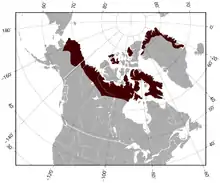Northern collared lemming
The northern collared lemming or Nearctic collared lemming (Dicrostonyx groenlandicus), sometimes called the Peary Land collared lemming in Canada, is a small lemming found in Arctic North America and Wrangel Island. At one time, it was considered to be a subspecies of the Arctic lemming (Dicrostonyx torquatus). Some sources believe several other species of collared lemmings found in North America are actually subspecies of D. groenlandicus.[2]
| Northern collared lemming | |
|---|---|
 | |
| Scientific classification | |
| Domain: | Eukaryota |
| Kingdom: | Animalia |
| Phylum: | Chordata |
| Class: | Mammalia |
| Order: | Rodentia |
| Family: | Cricetidae |
| Subfamily: | Arvicolinae |
| Genus: | Dicrostonyx |
| Species: | D. groenlandicus |
| Binomial name | |
| Dicrostonyx groenlandicus (Traill, 1823) | |
 | |
| Northern collared lemming range (not including the Wrangel lemming)[1] | |
| Synonyms | |
|
kilangmiutak Anderson & Rand, 1945 | |
Description
It has a short chunky body covered with thick grey fur with a thin black stripe along its back and light grey underparts. It has small ears, short legs and a very short tail. It has a pale brown collar across its chest. In winter, its fur turns white, and it has large digging claws on its front feet. It is 14 cm long with a 1.5 cm tail and weighs about 40 g.
Distribution and habitat
It is found in the tundra of northern Canada, Alaska and Greenland. A disjunct population is also present on Wrangel Island in Siberia; this population was formerly considered its own species, the Wrangel lemming (D. vinogradovi).[3][4][5]
Diet
It feeds on grasses, sedges and other green vegetation in summer, and twigs of willow, aspen and birches in winter.
Predators
Predators include snowy owls, gulls, wolverines, the Arctic fox and the polar bear.
Breeding
Female lemmings have two or three litters of four to eight young in a year. The young are born in a nest in a burrow or concealed in vegetation.
Behaviour
It is active year-round, day and night. It makes runways through the surface vegetation and also digs burrows above the permafrost. It burrows under the snow in winter. Lemming populations go through a three- or four-year cycle of boom and bust. When their population peaks, lemmings disperse from overcrowded areas.
References
- Cassola, F. (2017) [errata version of 2016 assessment]. "Dicrostonyx groenlandicus". IUCN Red List of Threatened Species. 2016: e.T42618A115195764. doi:10.2305/IUCN.UK.2016-3.RLTS.T42618A22331908.en.
- Musser, G.G.; Carleton, M.D. (2005). "Superfamily Muroidea". In Wilson, D.E.; Reeder, D.M (eds.). Mammal Species of the World: A Taxonomic and Geographic Reference (3rd ed.). Johns Hopkins University Press. pp. 971–972. ISBN 978-0-8018-8221-0. OCLC 62265494.
- Trust), Rosalind Kennerley (Durrell Wildlife Conservation; Group), Rachael Gerrie (Small Mammal Specialist (2016-07-15). "IUCN Red List of Threatened Species: Dicrostonyx vinogradovi". IUCN Red List of Threatened Species. Retrieved 2021-09-05.
- "Explore the Database". www.mammaldiversity.org. Retrieved 2021-09-05.
- "The Mammals of Russia: A Taxonomic and Geographic Reference". ResearchGate. Retrieved 2021-09-05.
